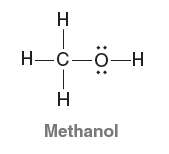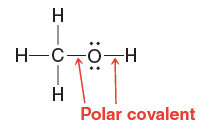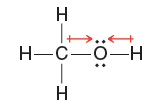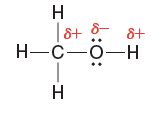Chemists classify bonds into three categories: (1) covalent, (2) polar covalent, and (3) ionic. These categories emerge from the electronegativity values of the atoms sharing a bond. Electronegativity is a measure of the ability of an atom to attract electrons. Table 1.1 gives the electronegativity values for elements commonly encountered in organic chemistry.
When two atoms form a bond, there is one critical question that allows us to classify the bond: What is the difference in the electronegativity values of the two atoms? Below are some rough guidelines:
If the difference in electronegativity is less than 0.5 , the electrons are considered to be equally shared between the two atoms, resulting in a covalent bond. Examples include C–C and C–H:
The C–C bond is clearly covalent, because there is no difference in electronegativity between the two atoms forming the bond. Even a C–H bond is considered to be covalent, because the difference in electronegativity between C and H is less than 0.5. If the difference in electronegativity is between 0.5 and 1.7, the electrons are not shared equally between the atoms, resulting in a polar covalent bond . For example, consider a bond between carbon and oxygen (C–O). Oxygen is significantly more electronegative (3.5) than carbon (2.5), and therefore oxygen will more strongly attract the electrons of the bond.
The withdrawal of electrons toward oxygen is called induction , which is often indicated with an arrow like this:
Induction causes the formation of partial positive and partial negative charges, symbolized by the Greek symbol delta  . The partial charges that result from induction will be very important in upcoming chapters.
. The partial charges that result from induction will be very important in upcoming chapters.
If the difference in electronegativity is greater than 1.7, the electrons are not shared at all. For example, consider the bond between sodium and oxygen in sodium hydroxide (NaOH):
The difference in electronegativity between O and Na is so great that both electrons of the bond are possessed solely by the oxygen atom, rendering the oxygen negatively charged and the sodium positively charged. The bond between the oxygen and sodium, called an ionic bond , is the result of the force of attraction between the two oppositely charged ions. The cutoff numbers (0.5 and 1.7) should be thought of as rough guidelines. Rather than viewing them as absolute, we must view the various types of bonds as belonging to a spectrum without clear cutoffs.
This spectrum has two extremes: covalent bonds on the left and ionic bonds on the right. Between these two extremes are the polar covalent bonds. Some bonds fit clearly into one category, such as C–C bonds (covalent), C–O bonds (polar covalent), or Na–O bonds (ionic).
However, there are many cases that are not so clear-cut. For example, a C–Li bond has a difference in electronegativity of 1.5, and this bond is often drawn either as polar covalent or as ionic. Both drawings are acceptable.
Another reason to avoid absolute cutoff numbers when comparing electronegativity values is that the electronegativity values shown above are obtained via a method developed by Linus Pauling. However, there are at least seven other methods for calculating electronegativity values, each of which provides slightly different values. Strict adherence to the Pauling scale would suggest that C–Br and C–I bonds are covalent, but these bonds will be treated as polar covalent throughout this course.
Consider the structure of methanol. Identify all polar covalent bonds and show any partial charges that result from inductive effects.
First identify all polar covalent bonds. The CH bonds are considered to be covalent because the electronegativity values for C and H are fairly close. It is true that carbon is more electronegative than hydrogen, and therefore, there is a small inductive effect for each C–H bond. However, we will generally consider this effect to be negligible for C–H bonds. The C–O bond and the O–H bond are both polar covalent bonds:
Now determine the direction of the inductive effects. Oxygen is more electronegative than C or H, so the inductive effects are shown like this:
These inductive effects dictate the locations of the partial charges:















